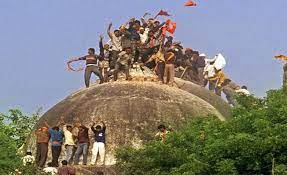 THE demolition of Ayodhya’s Babri Masjid in 1992 was an epochal moment in the post-independence history of India. As the frenzied mobs of Hindu hard-liners reduced the mediaeval mosque to rubble, based on the belief that it had been built atop the birthplace of Hindu deity Ram, their actions also dealt a severe blow to Indian claims of secularism.
THE demolition of Ayodhya’s Babri Masjid in 1992 was an epochal moment in the post-independence history of India. As the frenzied mobs of Hindu hard-liners reduced the mediaeval mosque to rubble, based on the belief that it had been built atop the birthplace of Hindu deity Ram, their actions also dealt a severe blow to Indian claims of secularism.
In fact, the Babri incident announced the raucous arrival of the Sangh Parivar onto India’s national stage, perhaps the beginning of a journey that would one day culminate with an adherent of Hindutva in India’s driving seat.
However, what is troubling is that the ghosts of Ayodhya seem to have been revived, as a renewed movement against several historical mosques and Muslim monuments has begun to gain momentum in India.
In the Hindu holy city of Varanasi, formerly Banaras, tension surrounds the Gyanvapi mosque, as a group of women have claimed the image of a deity can be seen on one of the masjid’s walls. Moreover, a shivling has reportedly been discovered in the ablution pond, leading to a court order calling for the sealing of the ablution area.
In Mathura, a court application has been filed calling for a ban on azan at the Shahi Idgah as, according to some Hindu groups, the sanctum sanctorum of a temple dedicated to Krishna is located inside the mosque. One of the suits has been filed on behalf of Shri Krishna.
Monthly press Review magazine http://www.thepakaffairs.com/subscribe/mg2.htm
Meanwhile in Delhi, Hindu extremists are targeting the historical Qutub Complex containing the Qutub Minar, calling for temples demolished by Qutbuddin Aibak in the 12th century to be rebuilt.
The atmosphere in India regarding these historical disputes can be gauged by the fact that a non-Muslim Delhi University history professor was arrested after he questioned the authenticity of the Gyanvapi mosque shivling claims online.
Unfortunately, in their quest to rewrite history, Hindu fundamentalists in India are stoking the fires of communal enmity. Their attempt to mix history, religion and politics creates an incendiary situation that can have far-reaching consequences for communal peace.
While indeed Muslim kings and sultans did demolish temples, should the Muslim citizens of modern India be made to pay for their actions? Moreover, there is a sufficient body of evidence that suggests that Hindu rajas also targeted temples patronised by rivals, while also attacking Buddhist and Jain places of worship.
Clearly, the Sangh Parivar’s moves are not about religious freedom or access to places of worship. Rather, they are part of a systematic attempt to erase India’s Islamic history, and permanently marginalise its Muslim population. Instead of learning from history and creating a society in which different races and religions can coexist, India’s extremists are trying to gain political capital from stirring up religious hatreds of the past.
While India’s current rulers are very much wedded to Hindutva, civil society needs to speak up before this madness spreads
Time Magazine http://www.thepakaffairs.com/subscribe/mg2.htm
